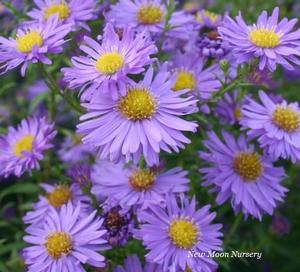New Moon Nurseries
Aster novi-belgii
New York aster
Native to North America
FIRST IMPRESSIONS: Along with the goldenrods and native grasses, asters are the quintessential herbaceous fall color plants of North America. This one is a robust upright perennial with smooth gray-green leaves. Aster novi-belgii is lovely in fall when crowned with sprays of starry purple daisies. Plants are adaptable to most moist sunny sites.
HABITAT & HARDINESS: Aster novi-belgii occurs in Eastern North America from Quebec through New England and south in the Atlantic Coastal Plain to South Carolina.
Plants are hardy from USDA Zones 4-8.
PLANT DESCRIPTION: Aster novi-belgii is a sturdy clump forming perennial with lance shaped leaves that clasp the stem.
Large flower heads are arranged in showy panicles. The heads consist of a ring of 20 or more purple or pink or occasionally white ray florets that surround a central cluster of yellow disc florets. Flowers are frequented by Monarchs and other butterflies, skippers and bees.
Plants grow 3-4’ tall with 3’ spread.
CULTURAL & MAINTENANCE NEEDS: Culture is easy in sunny sites with moist well drained soil. Plants thrive in part sun and in sandy or clay soils.
This wildflower tolerates some drought but unattractive or diseased foliage may develop if drought is severe. Plants may also die out in the center if they are not divided periodically.
Aster novi-belgii sometimes has issues with powdery mildew. To prevent the disease give plants good growing conditions and space for air circulation. In gardens, locate this aster in plenty of sun, irrigate during drought and limit overcrowding by using appropriate spacing for companion plants.
Plants can be pruned back to 6” early in the season to control height and promote stronger stems. Cutting should be curtailed by the end of June so that flowers have time to develop. Prune again after flowering if self-seeding is a problem or if foliage is bedraggled.
Plants are fairly unpalatable to browsing deer and rabbits.
LANDSCAPE USES: This is a good choice for a Seaside Garden, Wildlife Garden or Moist Meadow. Plants are also used as Butterfly Nectar Plants or as part of a Grouping or Mass Planting. Aster novi-belgii has Showy Blooms and is appropriate for Cottage Gardens, Deer Resistant Plantings, Low Maintenance Plantings, Perennial Borders and Restoration Projects.
COMPANION & UNDERSTUDY PLANTS: Try pairing Aster novi-belgii with Asclepias incarnata, Iris versicolor, Solidago nemoralis, Rudbeckia laciniata or Panicum virgatum.
Aster novae-angliae or Aster puniceus would be a suitable replacements due to similar height, flower color and cultural needs.
TRIVIA: Many of the established Latin names of Aster spp. were changed recently due to DNA and genetic research findings. So Aster novi-belgii is now known as Symphyotrichum novi-belgii.
Plants host caterpillars of several different moths.
This aster is sometimes called Michaelmas daisy because it blooms around September 29 which is St. Michael’s Day.
The specific epithet novi-belgii means New Belgium and is a throwback to the days when the state of New York was known as New Belgium.
Often confused with Aster novae-angliae. Differences include the fact that Aster novi-belgii has smoother foliage without a lot of pubescence and about half as many ray florets.
Height:
3-4 ftSpread:
3 ftSpacing:
4-6 ftUSDA Hardiness Zone:
4-8Bloom Color:
PurpleAster novi-belgii Characteristics
Attracts Wildlife
- Butterflies
Attributes
- Cut Flower
Exposure
- Full Sun to Partial Shade
Deer Resistant
- Deer Resistant
Flowering Months
- October
- September
- August
Foliage Color
- Green
Juglans nigra Tolerance (Black Walnut)
- Yes
Salt Tolerance
- Medium
Soil Moisture Preference
- Moist to Wet
Interesting Notes:
AKA Symphyotrichum novi-blegii
For more information on this plant, visit the USDA PLANTS Database: http://plants.usda.gov/java/profile?symbol=SYNON
